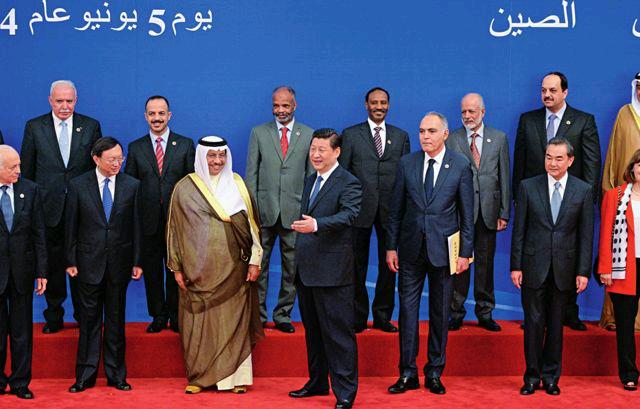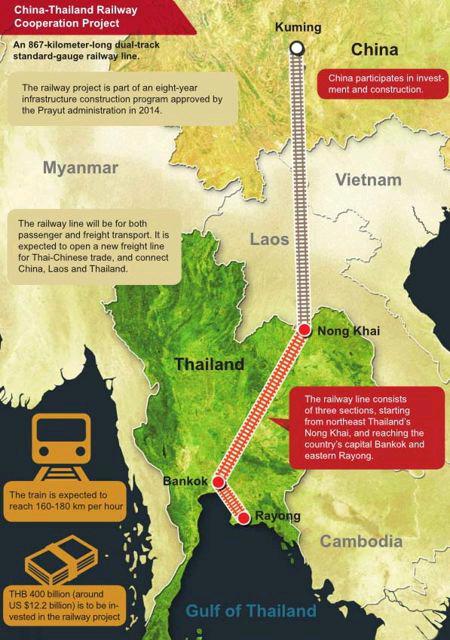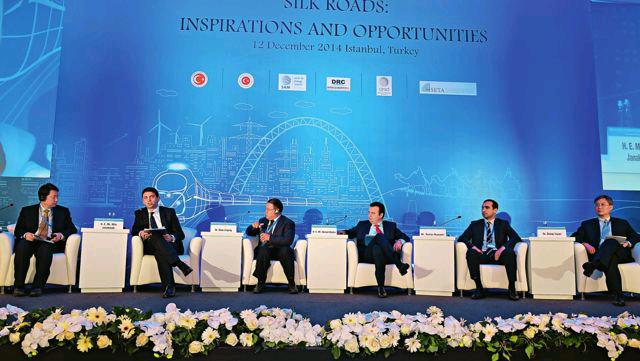Constructing the “One Belt and One Road”Tangram
By+ZHANG+XUDONG
THE earth had no roads to begin with, but when many men pass one way, a road is made.” This quote from Lu Xun, a leading figure of modern Chinese literature, describes the legendary history of the ancient Silk Road from one angle. For the Chinese, historical figures such as Zhang Qian and Ban Chao who served as envoys to the Western Regions are household names. But the Chinese are also very familiar with an envoy from the West, Marco Polo, who set out on his trip to China in 1271, and after three years of traveling met and received a warm welcome from Kublai Khan, founder of the Yuan Dynasty (1271-1368). The route that Marco Polo took was the Silk Road, yet it was not known as such back then. In the shadow of this famous Italian envoy is a lesser-known figure, the German geographer Ferdinand von Richthofen, who conducted two expeditions to China in the 1860s and compiled the masterpiece China: The Results of My Travels and the Studies Based Thereon. It was von Richthofen who coined the term “Silk Road.”
Generations of explorers of the Silk Road have braved challenges and risks to form the rich history of exchanges between China and Europe. Today, Chinas strategic initiatives to build the Silk Road Economic Belt and the 21st-Century Maritime Silk Road have witnessed bounding development. As Chinas Foreign Minister Wang Yi said, the Belt and Road Initiatives, serving as an overarching architecture for Chinas external cooperation endeavor in the new era, are bound to breathe new life and vigor into the ancient land of Eurasia and give this vast continent two strong wings for its flight toward prosperity.
China is leading the way in the historic mission to construct one belt and one road. Chinese leaders are playing multiple roles as planners, publicists and supervisors, actively and steadily promoting the initiatives. For more than one year since the scheme was proposed, over 50 countries along the routes have responded and participated in its construction, showing the proposals huge influence and appeal. As a world focus, the “One Belt and One Road” tangram is formed of the following seven pieces.
I. Common Development and Shared Prosperity
For a long time the international community has questioned how a rising China participates in the international community and builds the international order. As for proposals made by China, the world cares more about the value and conception of China they represent. So with the Belt and Road Initiatives, various countries hope that China will make clear its wider purpose and strategic thinking.endprint
On this point, Foreign Minister Wang Yi responded when he attended the 2014 Seminar on International Situation and Chinese Diplomacy. He said that the Belt and Road initiatives, in the spirit of mutual learning and harmonious coexistence reminiscent of the ancient Silk Road, are designed to boost common development and shared prosperity in all countries along the routes, as they uphold the vision for a community of shared destiny. His elaboration explicitly answers the questions from the international community and is consistent with the diplomatic concept and policy of Chinas new leadership. Further, it embodies Chinas effort to actively participate in the building of international order. The Belt and Road will connect scores of countries in the Eurasian Continent and will enable billions of people to learn from each other under the new wave of globalization, cooperate with each other and seek opportunities for common prosperity and development. Just like the saying goes, “a single flower does not make spring, while one hundred flowers in full blossom bring spring to the garden.” The rise and development of China is a positive factor for the world. China does not indulge in self-admiration, but hopes the international community can benefit from its fast development and achieve common progress. In that process, China is happy at the prospect of forming a community of shared destiny through connectivity and cooperation.
II. Discussion, Co-construction and Sharing
When the Belt and Road Initiatives were proposed, some commentators held that it was a one-sided wish by China and feared that other countries would not support it. Others were worried that the initiatives would follow the old pattern adopted by developed countries whereby only the big nations would have a say in decision making when establishing relevant international organizations or schemes. It is normal for a newly emerged concept to generate doubts. However, the Belt and Road initiatives are self-explanatory.
If we closely observe Chinas decision-making methods when participating in regional activities and its interaction with international organizations, we can see that China actually pays great attention to the principle of consensus decision making. That is to say, on the multilateral level, a range of voices, from both big and small countries, are heard. China didnt rashly put forward the Belt and Road initiatives alone; it formally made the proposal after negotiating with relevant countries, most notably after synthesizing the ideas of Kazakhstan. Moreover, all parties have discussed how they could best reap the most rewards in the process of their participation. The consent of all parties must be sought in implementing key projects. Relevant countries jointly provide money for the construction, and share the results. A method such as this that emphasizes equality and mutual benefit not only reflects Chinas core principle of diplomacy, but also forms the foundation for the construction of the Belt and Road initiatives.endprint

III. High Degree of Political Mutual Trust
“One belt and one road” is a tough project which faces complicated challenges. The core challenge is the endlessly emerging safety issues and conflicts among the countries on the vast Eurasian Continent and along the coast, including the threats from terrorism, ethnic separatism and religious extremism, geopolitical conflicts triggered by territory disputes, lasting turmoil caused by national conflicts and disputes over territorial waters and sea rights. For this reason some observers and media in the international community are skeptical about the initiatives.
But such a pessimistic outlook ignores the value and effect of the partnerships that have been built by China in its diplomatic history. Many countries along the routes are strategic cooperation partners of China. Take Kazakhstan, Serbia and Thailand as examples. Those countries have formed profound friendship and enjoy a high-degree of political mutual trust with China, thus laying down a solid foundation for the construction of one belt and one road. Those countries have also exerted a positive influence on their neighbors to build a relationship with China. From another perspective, one of the key reasons for the outbreak of safety-related contentions lies in the conflicts of interests. However, the construction of one belt and one road will unite nations interests and help cultivate a cando attitude, which is conducive to promoting cooperation among disputing countries. That is an additional positive effect of the Belt and Road initiatives.
IV. Sub-regional Organizations and Mechanisms
In promoting the Belt and Road Initiatives, subregional cooperation mechanisms that China has established with countries and regions in the belt and road areas will play key roles. This was evidenced at the 13th prime ministers meeting of the Shanghai Cooperation Organization (SCO), the third China-Central and Eastern European (CEE) Leaders Meeting, and the fifth summit of the Greater Mekong Sub-region Economic Cooperation, which Premier Li Keqiang attended.
The Joint Communiqué released by the SCO prime ministers meeting last December stated that the attending prime ministers welcome Chinas Silk Road Economic Belt Initiative and declared that it was important for SCO member countries to negotiate and cooperate under the initiatives framework. A statement following the third China-CEE Leaders Meeting elaborated on 10 aspects of bilateral cooperation in promoting connectivity. At the fifth summit of the Greater Mekong Sub-region Economic Cooperation, all delegates positively responded to Chinas proposal on strengthening connectivity. These three cooperative mechanisms, connecting Central Asia, Central and Eastern Europe, and the Indo-China Peninsula, which all fall under the belt and road, bring Chinas sub-regional diplomatic cooperation into full play, thus effectively boosting the schemes.endprint
V. Transportation Network
One of the major goals of the Belt and Road schemes is to expand the traffic capacities of the regions involved by effectively connecting regional transportation networks. The countries along the proposed belt and road have different features and advantages in transportation. While promoting regional connectivity, diversity should be kept in mind and taken advantage of in order to enhance transportation networks based on existing conditions.
One striking highlight in recent moves of the Belt and Road Initiatives is the construction of the BelgradeBudapest railroad. In November 2013, China, Serbia and Hungary declared they would jointly build the railway line. Last December, at the third China-Central and Eastern European (CEE) Leaders Meeting, the related countries unanimously agreed to extend the railroad within reach of over 32 million people to Piraeus, Greece, and jointly build the Central European land-sea express. The railway line will serve as a new convenient transportation line for Chinas exports to Europe and European exports to China, significantly enlarge China-Europe trade scale, and fuel development of countries along the route, thus narrowing regional divides and promoting the balanced development of the whole European Continent.
Meanwhile, construction of an 800-kilometer-long railway line connecting the north and south of Thailand, a cooperation project with China, has also made significant headway. Chinas technology, standards and equipment are adopted in the project, which is expected to bring about a surge in the economic development of the Greater Mekong sub-region.
VI. Diversified Cooperation
The appeal of the Belt and Road Initiatives comes from the huge cooperation benefits, which have launched the proposals into the world spotlight and made them welcomed and applauded by the affected countries. Against the backdrop of a sluggish world economic recovery, the initiatives are expected to fuel the development of related countries and smooth their economic transition by upgrading industries, improving infrastructure and strengthening cooperation in diverse fields including investment, financing and energy. During the process, Chinas advantageous equipment manufacturing and industries will enable all parties to complement each others advantages through trade and cooperation.
The Belt and Road Initiatives have immeasurable potential and benefits to be tapped, and not just for China. For example, Kazakhstan is currently carrying out large-scale infrastructure construction and a plan to revitalize its economy; with Chinas help, Kazakhstan could accelerate its development.
VII. Cultural Exchanges Smoothing the Initiatives
Cultural exchanges will play an indispensable role in the Belt and Road projects. The core of connectivity is to realize people-to-people exchanges and strengthen them in multiple fields including science, environmental protection, culture, education and media. By promising returns for the people, the initiatives will gain support and ultimately promote mutual understanding and friendship across borders.
Through “one belt and one road,” a China craze is taking shape and sweeping Eurasia. Chinas continuing rise is generating a new driving force for the international community to go onwards and upwards together.endprint

